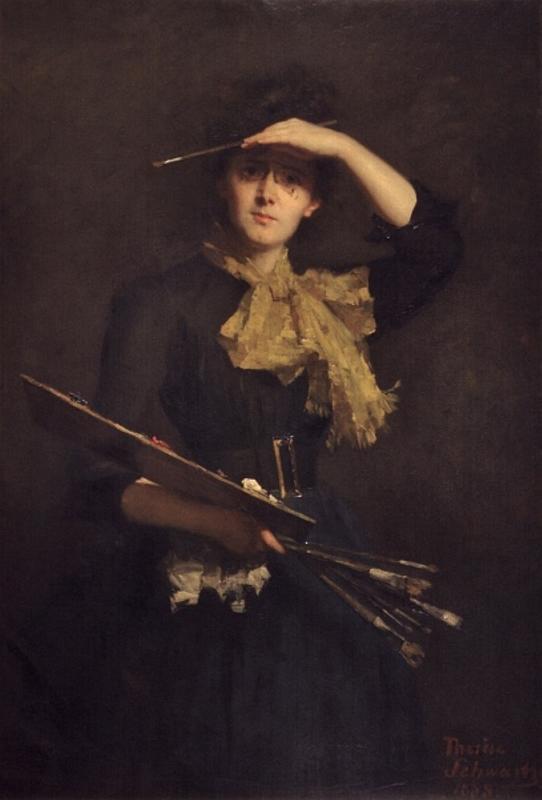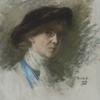More about Portrait of Thérèse Schwartze

Contributor
Schwartze's Self-Portrait is one of the few 130-year-old self-portraits that can say it remains in the same gallery that commissioned it.
Of course, it can't really say anything, but if it could, it would. It would also say that it was instrumental in making Schwartze the first woman knight of the aristocratic Order of Orange-Nassau, and it would tell you about the gold medal it received in Paris when it was a year old. This work has other names, including 'Mlle Thérèse Schwartze faisant son portrait' ('Ms. Therese Schwarze doing her portrait') and 'Self-portrait with palette.'
Is there any significant reason that English, and even Dutch-language, scholarship neglects this work, while writing volumes about the works of other Dutch artists of the time, like Vincent van Gogh? There are a number of reasons, but most of them are not very good ones. Van Gogh's style is, of course, radically different, and represents a sharp, progressive break with tradition. Schwartze spent her entire life proving to the world that a woman could be just as important to the prominent Netherlandish painting tradition (even though women have been part of it for a long time.) The Italian government, on the other hand, specifically chose her for its prestigious collection of self-portraits in the Galleria degli Uffizi, and they said that her work was the greatest of the collection, according to a contemporary magazine. "None of her Dutch colleagues in her time got that honor, only Rembrandt from the 18th century,” adds Schwartze-ologist Cora Hollema. If the Uffizi had known who van Gogh was, they still would have passed, partly because he had none of the suave, aristocratic professionalism of Schwartze, who hobnobbed with the elites and had a reputation as the best portraitist in Amsterdam.
Part of the prestige of van Gogh today, paradoxically, has to do with the fact that nobody appreciated him when he was alive, and writers love to correct historic injustices. But the writerly injustice against the name of Schwartze is just as unfortunate, given that her work is just as significant as van Gogh's, and she is a major link in the Dutch tradition that goes back to Johannes Vermeer and Michaelina Wautier. The sexiness of van Gogh, to a writer, is that we discovered him posthumously, and he was a great innovator. But van Gogh's obscurity was also a cloak of protection: he didn't have to deal with the high-society insults that people heaped on Schwartze, because they didn't know his name. Twenty years after this work, an art magazine gives her an introduction with a reproduction of the picture, saying that her work is "derived from" Rembrandt and her father, then cites an artist who wrote that: "If she were a man she would accomplish really great things, but that woman's lack of self-confidence might stand in her way." The guy then adds that she lost the skill she inherited from dad, and her painting now relies more on "effect" than "characterisation."
None of that is true. For her own survival, Schwartze was developing character every step of the way, as you can see in this work. By casting herself in the posture of Joshua Reynolds in his portrait that hangs in the National Gallery of London, Schwartze's confidence allows her to shift between masculine and feminine roles, assuming a womanliness that, in the words of Joan Rivière, can be "assumed and worn as a mask" to achieve certain objectives. The pose might even "stage a silent revolt against gender restrictions and invade male territory otherwise closed." Of course, as Judy Chicago might say, it would be better not to have to wear male drag at all, for women to have their own institutions and their own systems of prestige.
Sources
- Chernick, Karen. "The Unusual Career of Portraitist Thérèse Schwartze." Art & Object, Jan. 20, 2020, https://www.artandobject.com/articles/unusual-career-portraitist-theres….
- Corbett, David Peters, and Lara Perry. English Art, 1860-1914: Modern Artists and Identity. Manchester: Manchester University Press, 2000.
- "Self-portrait with palette." The Athenaeum, https://www.the-athenaeum.org/art/detail.php?ID=82044.
- "Sir Joshua Reynolds." National Portrait Gallery, https://www.npg.org.uk/collections/search/portrait/mw05282/Sir-Joshua-R….
- The Feminist Art Journal, Volume 2, Issue 3. New York: Feminist Art Journal, 1973.
- The International Studio, Volume 42. New York: John Lane, 1911.











